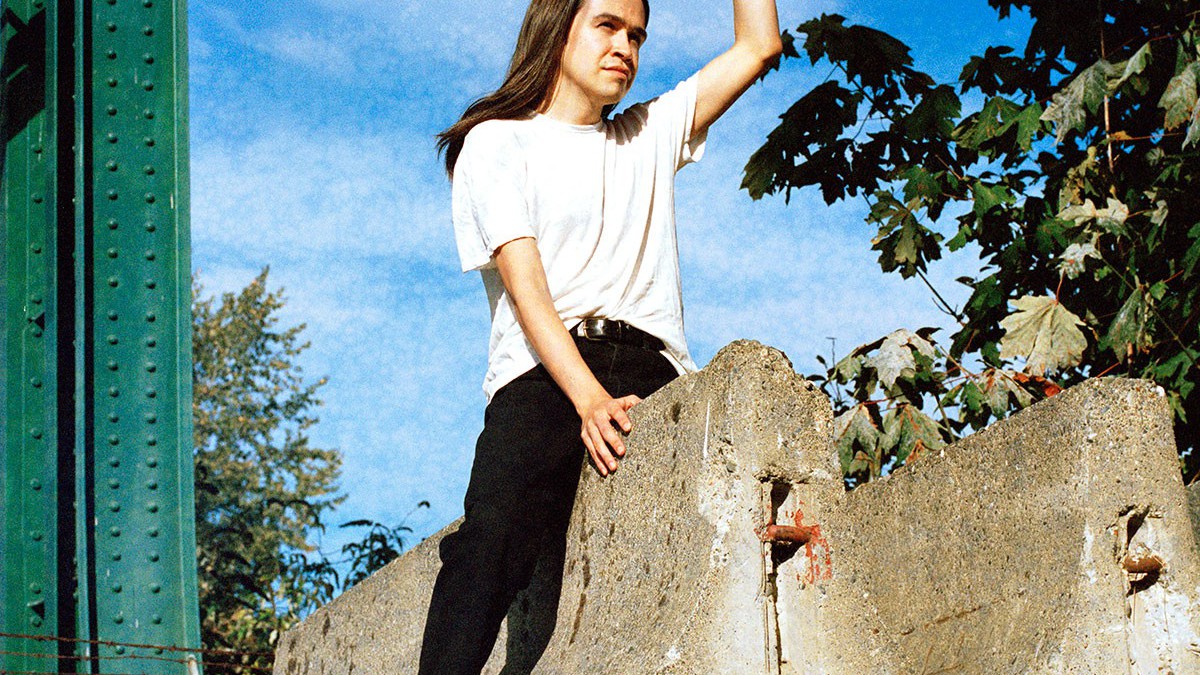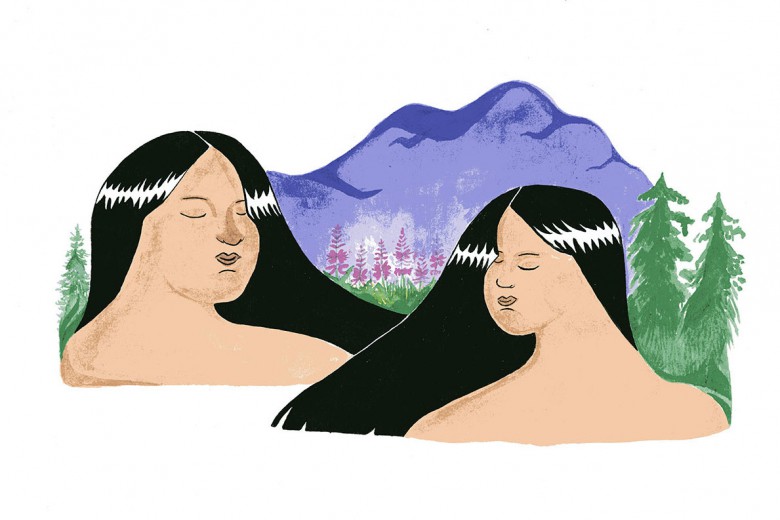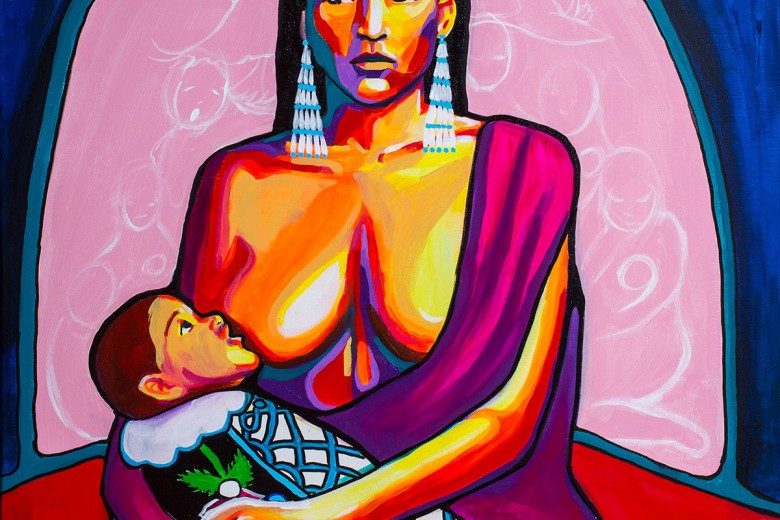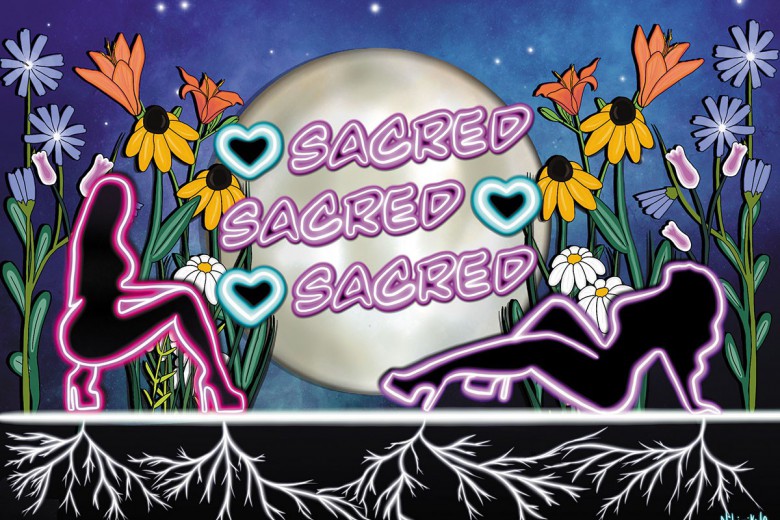What does Land Back mean for Indigenous Peoples who live in the city? As a Cree-Métis-Saulteaux person who grew up in Regina and lived in Edmonton for six years, the first thing that comes to mind is the urgency of dismantling the surveillance mechanisms of the prairie settler state.
During my teens in Regina, I was a street-involved, houseless youth who would hang out downtown, which always seemed to make me hyper-visible to white settlers who wanted to police my presence: the parents who told their white children that they can’t play with “Indians”; the teachers who viewed my sexuality (namely, the time I drew a boy’s name in a heart on my desk) as a danger to impressionable young men; the old white women who would give me dirty looks downtown; the doctor who almost killed me by giving me inadequate health care; and so many other people who always let me know while growing up that I was different. I carried those feelings of inadequacy with me when I moved to Edmonton and made my home in communities populated by folks who are considered socio-economically disadvantaged, whatever that means. The surveillance followed, too. During this time, I was assaulted one block away from my house, while walking home, by Officer 3191 of the Edmonton Police Service, though I was never placed under arrest. The criminalization did not ease.
I have always felt and known that the city was land, too. I know now that surveillance and violence against us is a way of continuing to remove us from the land.
I’ve wondered what it would mean to walk freely on my own lands without fear of surveillance by white prairie settlers and criminalization by the institutions that serve their interests. I have always felt and known that the city was land, too. I had solidarity with other street-involved Indigenous youth based on our shared experience of state violence. I know now that surveillance and violence against us is a way of continuing to remove us from the land. Surveillance is how my sovereignty was – and is – taken away from me; how I am told every day in the prairies that I am less-than.
There’s a strange dualism of being an Indigenous person who loves white people who harbour unchallenged racist values – it’s a form of race consciousness. I know that Indigeneity is not often talked about in academic studies of race, but I stand by my choice to do so. What else is visible surveillance and criminalization on the basis of being a part of a cultural group, if not racism? Being an Indigenous kid who grows up and realizes how much your white family functions through racism, and continues to normalize racism in your presence, is the basis of adult trauma work for many mixed, adopted, and foster care NDNs. Indigenous youth don’t need university degrees and academic language to make our experiences of racism valid – we have been working through these concepts in our minds, through our bodies, and within our own families for a long time.
I dreamed that if I have the embodied gestures of my ancestors – my ability to share song and story, or my scrappy, fire-starter ways – then perhaps white settlers do too; and that was a place from which to start healing.
I’ve questioned if empathy could heal the relationships that create racist attitudes in the present. I wanted to know: what were the rhetorics in white settler families that informed their internalized racism against Indigenous people and caused them to surveil, and perhaps dehumanize, me? What caused them to have physical reactions to Indigenous bodies in Prairie cities? I dreamed that if I have the embodied gestures of my ancestors – my ability to share song and story, or my scrappy, fire-starter ways – then perhaps they do too; and that was a place from which to start healing.
Why did someone at the Sage Creek Liquor Mart call the police on Eishia Hudson the day she was shot to death by the Winnipeg police? Why have we allowed the Saskatoon police force to stop, question, and document any Indigenous person on the street? Perhaps they were emboldened after the justice system failed to hold them accountable for the starlight tours? Why did the white people at Wascana Lake refuse to call for help the day that Darlyn Johns drowned, even though his friend desperately begged to borrow the phones of onlookers for half an hour after Johns disappeared in the water? Why did white farmers in Saskatchewan use the shooting death of Colten Boushie as a platform for their white nationalist politics? These aren’t rhetorical questions. I wanted to know because I imagined that, if I had proof, somehow anti-Indigenous surveillance in the Prairies would be undeniable; that if white people saw the ways they hurt Indigenous peoples by surveilling our bodies, perhaps they would have empathy with us, too.
I received over 70 messages from white settlers who wanted to process, with an Indigenous person, instances of anti-Indigenous racism within their family. Reading these confessions felt so hollow.
I posted on Twitter asking if there were any white folks who might be open to sharing with me their experiences of racism within their own families. I received over 70 messages from white settlers who wanted to process, with an Indigenous person, instances of anti-Indigenous racism within their family. Reading these confessions felt so hollow. There was no resolution for me in their words, which only hurt to read.
Surveillance is, by definition, an unequal power relation: the person surveilling has power over the person being surveilled. Certainly, I can attempt to surveil white supremacy from the outside, but it would never have the same impact – and even if I did get “proof” I was being surveilled, I knew it would never be enough to change white people’s behaviour. Evidence of police brutality in the form of body camera videos, for instance, has not stopped police officers in Canada and the U.S. from killing Black and Indigenous people; nor has it facilitated healing, justice, or closure for Black and Indigenous communities. The white settlers who contacted me did not want to support my truth. They wanted a quick solution to alleviate their guilt. They wanted confession. They wanted to be able to buy their freedom from complicity in white supremacy through creative philanthropy.
The anti-Indigenous rhetorics I am describing, the ones that are used to legitimize the surveillance and policing of Indigenous presence in the Canadian prairies, hearken back to conflict between early white settlers and Indigenous populations. As Gina Starblanket and Dallas Hunt have written in their book Storying Violence: Unravelling Colonial Narratives in the Stanley Trial, the shooting death of Colten Boushie and subsequent trial of his killer, Gerald Stanley, provides a gut-wrenching example of how Indigenous presence is seen as a threat to settler-colonial safety in the Canadian Prairies, and it is policed as such. In a Globe and Mail article, Starblanket and Hunt argue that Canadian settlement relies on the ideal of patriarchal nuclear families, at the centre of which is the white farmer’s ownership of his kingdom – the open prairie – where his castle lies. This image upholds a cult of toxic white masculinity in the Prairies, which is necessary to protect the safety of white settler children, wives, and property, even if that means criminalizing and killing Indigenous people.
Surveillance is, by definition, an unequal power relation: the person surveilling has power over the person being surveilled. Certainly, I can attempt to surveil white supremacy from the outside, but it would never have the same impact.
Technology has become interwoven with race and surveillance in the Prairies. What comes to mind when I think about the digital surveillance of Prairie Indigenous communities is Facebook Karens. White women in the prairies will take to Facebook to have long arguments on posts, coming out in favour of policing and criminalizing Indigenous people in the Prairies. Following the Stanley trial, I saw these arguments play out on my white family’s Facebook walls.
I thought back to high school and the platforms I used, like MSN Messenger and Myspace (to date myself). I found that, based on the codes I received on social media from skinny white scene kids, I would police myself, reminding myself what was and wasn’t attractive – what was deemed right. I would find myself changing my appearance to make myself blend in more. I’d dye my hair and buy clothes that I thought conveyed that I had access to resources. I aligned myself with more liberal, white, and white-coded friends. Indigenous surveillance and policing is personal, intimate, and embodied. And the cycle repeats forever, as Starblanket and Hunt note. White women police me in order to advocate for their own safety and to protect the nuclear colonial family structure and the men at the helm of “good” white prairie families. Police then criminalize Indigenous presence in the city on behalf of white prairie families. I modify my body and actions to be less surveilled (which, I acknowledge, is an immense privilege). And it all maintains the order of white supremacy at the expense of Indigenous life in the Prairies.
And, yes, Land Back is filming Karens who are harassing Indigenous youth and posting those videos online so they, too, can know what it’s like to be constantly surveilled.
By looking to white prairie communities for an answer about why they dehumanize me, why they couldn’t have empathy for me and the forms of violence I have experienced because of my hyper-visible presence in the city centres of Regina and Edmonton, I realized they didn’t even know what caused it because all they knew was rigid conformity that maintained the status quo – and thereby their own power – in the Prairies. I wasn’t searching for proof. I wanted closure. I wanted to heal. And I’ve done enough community healing work to know that closure and self-worth don’t come from others; it comes from within. Heal yourself, and you heal your descendants. Heal your kin, and you heal yourself. That is something that white people will never understand because they are so disconnected from their own territories, so deeply entrenched in the racist ideologies of colonialism that inform their identities.
Land Back is actively working toward the decriminalization of Indigenous youth in the city to ease these forms of surveillance and death. White people should actively put their bodies and resources on the line for Indigenous youth who are criminalized in their communities. And, yes, Land Back is filming Karens who are harassing Indigenous youth and posting those videos online so they, too, can know what it’s like to be constantly surveilled. Land Back means that white people, including elderly folks, will be called out and will no longer get a pass for casually naturalizing forms of racism. Gen Z came to the game ready to fight.
Land Back in the city is the embodied resurgence of street-involved and houseless youths. Land Back is defunding the police.
Land Back is for Indigenous Peoples in the city, too. Land Back is reclaiming physical and temporal space in the Prairies. Land Back in the city is the embodied resurgence of street-involved and houseless youths. We need to be safe on our own lands. Land Back is defunding the police. Land Back is taking care of our bodies. When you’re without a home, your body is your only home. Land Back is taking care of each other. Land Back is better harm reduction for drug users in the city, with white settlers funding these kinds of supports. Land Back is shelters for trans and queer Indigenous youth, who are often not allowed in women’s shelters because those shelters demand binary gender presentations. Land Back is wet shelters. Land Back is more infrastructure for houseless communities, generally. Land Back is the decriminalization of youth sex work. Land Back is ending the policing of Indigenous drug users and suppliers.
The city is land, our bodies are the land, so, please, white settlers, give Indigenous street-involved youth our body sovereignties and our geographies back. Stop criminalizing us. Stop normalizing our death. Kill the racist settlement rhetorics in your own minds and families.







